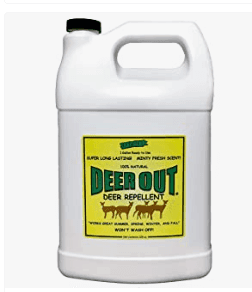Deer can be a major nuisance for homeowners, causing damage to lawns, gardens, and landscaping. While there are many ways to control deer populations, using deer repellents based on taste is a popular and effective method. When using taste based repellents, you may have to accept a little bit of damage. The deer must eat something to taste something. The alternative to taste based is scent/smell based where the deer are repelled before eating and doing any damage. In this article, we will discuss the top 10 deer repellents based on taste, their chemical deer control products, and the pros and cons of each.
- Deer Out
Deer Out is a natural deer repellent that uses essential oils to repel deer. The active ingredients in Deer Out include peppermint oil, rosemary oil, and garlic oil. It is effective for up to three months and is safe for use on plants, trees, and shrubs. However, Deer Out may not be as effective in heavy rain or in areas with high deer populations.
- Bobbex Deer Repellent
Bobbex Deer Repellent is another natural deer repellent that uses a combination of taste and scent to repel deer. The active ingredients in Bobbex include putrescent egg solids, garlic oil, and fish oil. It is effective for up to two months and is safe for use on plants, trees, and shrubs. However, Bobbex may have an unpleasant odor and may need to be reapplied frequently.
- Liquid Fence Deer & Rabbit Repellent
Liquid Fence Deer & Rabbit Repellent is a natural deer repellent that uses a combination of taste and scent to repel deer. The active ingredients in Liquid Fence include putrescent egg solids, garlic oil, and clove oil. It is effective for up to two months and is safe for use on plants, trees, and shrubs. However, Liquid Fence may not be as effective in heavy rain or in areas with high deer populations.
- Plantskydd Animal Repellent
Plantskydd Animal Repellent is a natural deer repellent that uses dried blood to repel deer. The active ingredient in Plantskydd is porcine and/or bovine blood. It is effective for up to six months and is safe for use on plants, trees, and shrubs. However, Plantskydd may have an unpleasant odor and may need to be reapplied frequently.
- Deer Scram
Deer Scram is a natural deer repellent that uses a combination of taste and scent to repel deer. The active ingredients in Deer Scram include dried blood, garlic oil, and white pepper. It is effective for up to three months and is safe for use on plants, trees, and shrubs. However, Deer Scram may not be as effective in heavy rain or in areas with high deer populations.
- Deer Stopper Concentrate
Deer Stopper Concentrate is a natural deer repellent that uses a combination of taste and scent to repel deer. The active ingredients in Deer Stopper include cinnamon oil, garlic oil, and thyme oil. It is effective for up to three months and is safe for use on plants, trees, and shrubs. However, Deer Stopper may not be as effective in heavy rain or in areas with high deer populations.
- Liquid Fence Deer & Rabbit Repellent Granular
Liquid Fence Deer & Rabbit Repellent Granular is a natural deer repellent that uses a combination of taste and scent to repel deer. The active ingredients in Liquid Fence Granular include putrescent egg solids, garlic oil, and clove oil. It is effective for up to three months and is safe for use on plants, trees, and shrubs. However, Liquid Fence Granular may not be as effective in heavy rain or in areas with high deer populations.
- Repellex Systemic Deer Repellent Tablets
Repellex Systemic Deer Repellent Tablets are a chemical deer repellent that uses the active ingredient, capsaicin, to deter deer from feeding on plants. Capsaicin is a compound found in hot peppers and is known for its spicy taste. Repellex tablets are placed in the soil around plants, and when the plants absorb the tablets, they become unpalatable to deer. Repellex tablets are effective for up to six months and are safe for use on most plants. However, they can be expensive and may not be suitable for large areas.
- DeerPro Spring & Summer (Professional Solution)
DeerPro Spring & Summer is a natural deer repellent that uses a combination of taste and scent to repel deer. The active ingredients in DeerPro Spring & Summer include rosemary oil, garlic oil, and peppermint oil. It is effective for up to two months and is safe for use on plants, trees, and shrubs. However, DeerPro Spring & Summer may not be as effective in heavy rain or in areas with high deer populations. To read more about Professional Deer Control Services, check out our page.
- Deer No No
Deer No No is a natural deer repellent that uses a combination of taste and scent to repel deer. The active ingredients in Deer No No include putrescent egg solids, garlic oil, and clove oil. It is effective for up to two months and is safe for use on plants, trees, and shrubs. However, Deer No No may not be as effective in heavy rain or in areas with high deer populations.
Choosing A Deer Repellent Based on Taste
When choosing a deer repellent based on taste, it's important to consider the specific needs of your situation. For example, if you have a large area to protect, a chemical repellent like Repellex may be more effective than a natural repellent that needs to be reapplied frequently. Similarly, if you have a high deer population in your area, you may need to choose a stronger repellent or use a combination of repellents to achieve the desired effect.
Ultimately, the best deer repellent for your situation will depend on a variety of factors, including the size of your property, the type of plants you need to protect, and the severity of the deer problem in your area. By carefully considering the pros and cons of each option, you can choose the right deer repellent to meet your needs and keep your plants safe from hungry deer.
In addition to taste-based deer repellents, there are also other types of chemical deer control products that can be effective in deterring deer from your property. These include scent-based repellents, visual deterrents, and physical barriers.
Scent, Visual, and Physical Based Deer Deterrents
Scent-based repellents work by using odors that deer find unappealing to discourage them from coming onto your property. Some popular scent-based repellents include PredatorPee, which uses the scent of predator urine to deter deer, and Liquid Fence, which uses a mix of garlic and eggs to create an unpleasant odor for deer.
Visual deterrents work by using reflective surfaces or other visual stimuli to scare deer away from your property. Some popular visual deterrents include scarecrows, reflective tape, and predator decoys.
Physical barriers, such as fences or netting, can also be effective in keeping deer out of your garden or other areas of your property. However, these can be expensive and may not be practical for all situations.
When choosing a deer control product, it's important to consider the specific needs of your property and the severity of your deer problem. A combination of different types of repellents may be necessary to achieve the desired effect. It's also important to carefully read the instructions and follow all safety precautions when using any type of chemical deer control product.
Bitrex
Bitrex, also known as Denatonium Benzoate, is a bittering agent that has been used for decades as a deer repellent. But how did this discovery come about? Let's take a look. Bitrex is the most bitter chemical on earth and is very affective at stopping deer from eating something. They might take a bite, but they won't take a second bite.
It all began in the early 1950s, when the UK government was looking for a way to prevent accidental poisoning in children. At the time, many household cleaning products and pesticides had a sweet taste, making them appealing to children. But the government wanted to change that.
Scientists at a research facility began experimenting with different compounds to see if they could create a bitter taste that would deter children from ingesting harmful products. One chemist, Dr. Macfarlan Smith, discovered a compound called Denatonium Benzoate. It was incredibly bitter and effectively discouraged children from ingesting it.
But the scientists soon realized that Denatonium Benzoate had another unexpected use. They found that it was highly effective as a deer repellent. Its bitter taste made it unappealing to deer, who were deterred from browsing on treated plants. Bitrex is now widely used as a deer repellent in gardens, parks, and agricultural fields. Its effectiveness lies in its bitter taste, which deer find unappealing. It does not harm the deer and it is non-toxic to humans and animals.
So, there you have it. Bitrex, or Denatonium Benzoate, was discovered as a way to prevent accidental poisoning in children, but it has since proven to be an incredibly effective deer repellent. A true example of serendipity at work.
If you are making your own homemade deer repellent, you can add Bitrex to your concoction to make it work even better. Stark Brothers sells Tree Guard Deer Repellent that contains Bitrex.
In conclusion, choosing the right deer repellent based on taste can be an effective way to protect your plants from hungry deer. Chemical deer control products like the ones listed above can be a valuable tool in keeping deer away from your property, but it's important to carefully consider the pros and cons of each option before making a decision. With the right deer repellent and a little bit of patience, you can keep your garden safe and beautiful all year round.


